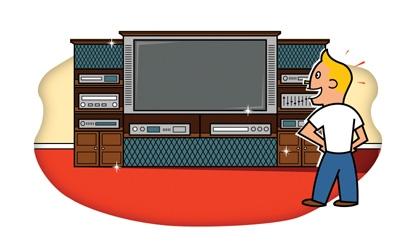The Custom Installer: Put It There

By nature, we're attracted to cool stuff, and A/V cabinetry usually isn't that cool. When somebody says, "Check out that rack!," component storage isn't the first thing that comes to mind. But your system needs to have a place to call home. Before deciding where you're going to put your gear, here are some things to consider.
Having enough space is Numero Uno. I prefer cabinets that are at least 20 inches wide so I can slip my hands along the sides of the components. Give me enough room to spin the components around inside the cabinet so I can make connections, and I might hug somebody! Having enough shelves so you don't have to stack everything Jenga-style is also nice. But depth is usually the deal killer. While the deepest component might be only 18 inches, you need space for the wiring that sits behind it.
Consider airflow. Components like surround receivers, cable-TV boxes, satellite-TV receivers, and any gear with hard drives tend to run hot. Stack them in an enclosed space and you're asking for trouble. That precious silicon might need some forced ventilation to keep from melting. But if you add a fan, make sure it pulls cool air in and vents hot air out - otherwise you're just creating a convection oven. And get something quiet. No one wants to hear the fan during a movie.
Decide where the gear will go while you're still planning your system. A simple rack beside the TV is inexpensive, but it eats up floor space and might not be pleasing to look at. Equipment stands without backs or sides are great for airflow and working on your gear, but they make it virtually impossible to hide the wires.
Slide-out racks from companies like Middle Atlantic provide a clean, flush-mounted look for your components, and they actually are kinda cool, but pricey. And since they mount into the wall, they should be installed during new construction or a remodel.
Prefab entertainment centers can be risky. Since nearly every A/V component is 17 inches wide, finding a cabinet is easy, right? Wrong. I've worked on projects where the inside dimensions were okay, but the door openings were only 15 inches.
A custom cabinet can be the best way to go, especially if you have a large system. Before choosing a cabinet shop, check with a local custom installer and ask for a recommendation. Then stay in touch with the cabinetmaker throughout the project. I've been burned even after giving the maker some scale drawings to work with.
My favorite storage solution is a dedicated closet with the gear loaded into a rolling rack. This keeps the electronics out of sight, provides tons of room for wire management, is easy to ventilate, makes working on the system a breeze, and offers gobs of space for upgrades. How can your wife complain about your A/V gear if she never has to see it? And when someone asks to check out your rack, you'll look pretty cool!
Back to Custom Installer Main Back to Homepage What's New on S&V













































